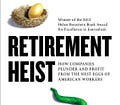RETIREMENT HEIST: AMERICAN PENSIONS AND THE ART OF BEING EVIL
Podcast by (the non-billionaire, non-pedophile, non-dead) Jeff Epstein for Historic.ly, recorded August 16-20, 2019. You can find Historic.ly on the web, Twitter, and Facebook. You can find Jeff at Citizens’ Media TV on Twitter, Facebook, and on the web. Music by Wreck Tech, who can be found on SoundCloud and Spotify.
Copy edited by Ben Szioli
Editor’s note: page numbers (“[9]”) are provided for those interested in more information on specific statements.
In 1999, pension funds at most large corporations were fully funded, meaning they could afford to pay all benefits for all employees, for all time – even if they all lived to the age of 100. On top of this, thanks to eight years of double-digit investment returns, in large part due to the dot-com bubble, many companies were sitting on massive pension fund surpluses: $7 billion at IBM, $20 billion at AT&T, $24 billion at Verizon, and $25 billion at GE [9]. These surpluses were intended to serve as cushions against unforeseen problems at the company or in the stock market, as were soon to occur during the housing crisis of 2008.
Companies complained that these surpluses should be freed up to use for “more productive purposes.” They lobbied the government until 1999, when Congress changed pension law so the surpluses could be used more freely [16]. The conditions of the new law were that the pension funds had to remain fully funded and the money taken was to be used “exclusively for the benefit of pensioners.”
As thoroughly documented by Ellen Schultz in her book Retirement Heist, this decision was a major factor in the massive incentives for executives to enrich themselves on the backs of millions of retirees, who sometimes paid with their very lives. Draining pension surpluses gave companies many billions of dollars that could be used for unorthodox purposes such as severance for employees who were laid off to keep their pensions from growing. [13-15]. Above all else, however, this money was used to provide executives with lavish performance and exit bonuses [19-23], while benefits for average workers were dramatically reduced or eliminated.
Since only the surplus could be drained, companies used a loophole to increase the surplus by lowering their pension funding level. They did this by feigning hardship due to what they said was the undue burden of a growing population of retirees (despite their plans being fully funded!). Companies told their employees that if they didn’t reduce future benefits, the company might be forced to declare bankruptcy, and the employees would lose everything. The benefits were then reduced, resulting in a magically larger surplus.
This cycle continued until the funds were nearly depleted, at which point the company could indeed claim bankruptcy, using the remaining balance in the pension fund to pay off company debtors instead of retirees [24].
Although this lawlessness existed for decades, the seed from which it grew at high speed was planted around a decade prior. In 1987, accounting standards were established [55] requiring companies to report their pension funds as a liability on financial statements. This meant that taking money out of a pension fund reduced those liabilities and would conversely be reported as earnings – no different than the profit from selling a product. These increased earnings increase investor confidence, which increases stock prices, which in turn results in larger bonuses for executives. Not to mention, the money taken can itself be kept tax- and consequence-free.
The earnings can also be used as a tool to hide financial problems with precision. For example, between 2003 and 2010, the major appliance company Whirlpool had three large recalls of defective products [78], resulting in substantial losses. However, instead of reporting a loss, they drained just enough money from the pension fund in order to report modest earnings every quarter.
In other words, slowly draining pension fund surpluses allows companies to hide volatility, pretending to the public (including workers, retirees, investors, regulators, legislators, and law enforcement), year after year, that the company is being run perfectly, regardless what actual difficulties it faced. This false perception of stability is then used to justify even more bonuses for executives.
So, each dollar taken from a pension fund enriches executives many times over.
Retirees have attempted to sue in order to recover lost benefits, but unfortunately, companies can reliably lengthen and postpone the proceedings for decades, until the retiree either gives up or dies. Until that point, the company can keep reinvesting the disputed funds, earning more interest. Retirees’ lawyers also cannot be compensated for legal fees unless a judge approves it on a case-by-case basis, making it difficult for retirees to afford litigation. [161-2]
Yet, grotesquely, companies are free to drain their pension fund surpluses in order to pay their lawyers [20], since the lawyers’ services are ostensibly aimed at “defending the pension fund,” which is, legally speaking, “for the exclusive benefit of pensioners.”
Finally, pension law does not allow for retirees to be financially compensated for pain and suffering [162]. This means that the worst possible consequence for a company is to have to repay what was originally owed. In Retirement Heist, the author Schultz likens this to being viciously beaten and having your wallet stolen, and the best you can hope for is to get your wallet back.
So, since workers and retirees have few legal protections, there is nothing to force a company to do better.
While these crimes (some made legal, some not) are disgusting, what’s really disgraceful is the system that allows it to happen. The private pension industry joins the industries of asbestos, tobacco, healthcare, pharmaceuticals, prisons, and many others, as yet another for-profit monster that has known for decades how its actions and inactions have caused, and still cause, the death and suffering of millions.
(Above all others, however, is the fossil fuel industry, which threatens untold devastation and suffering for all of humanity, with many of the consequences occurring before our grandchildren even have a chance to live out their natural lives. Yet this genocidal and ecocidal industry is still subsidized by more than a half trillion dollars from the United States government each year.)
Our government does absolutely nothing to stop these crimes. In exchange for legal bribes from the owners of these companies (in the form of campaign contributions), our elected representatives look away and shrug helplessly while the monsters prey upon us.
Worst of all, as Modern Monetary Theory (MMT) demonstrates, our government could easily protect and provide (pensions and all other basic human needs) for us all. So when a federal representative tells us that they want to help us but they can’t, they are, to be extremely charitable, incorrect.
Ellen Schultz’s book Retirement Heist documents the art of being evil; the creativity of evil. It is an endless stream of company after company, each company turning to the one before it, saying, “You think that’s evil? Hold my beer.”
My interest in reading this book is not to find solutions to all these pension-related crimes and problems, because they are all symptomatic. Instead, my goal is to understand them as context for a system that has lost its way – and hopefully as incentive to do something about it.
Postscript: Seven years later, the problem persists
Retirement Heist was published in 2012. As of 2017, 114 multi-employer pension plans are projected to fail within the next twenty years. In addition, the federal agency that insures all American private pensions says that it will run out of money by 2025 – despite MMT demonstrating that Congress could fully fund the agency and all pensions, for all time.
(To start learning about Modern Monetary Theory (MMT), you can find many expert created resources on the web, Twitter, and Facebook.)
Disclaimers and corrections regarding what I say in the audio
I say “there is no economic reason for the PBGC/the federal government to not be able to pay all pensions for all time.” The word economic should be changed to “financial.” The economy includes money and resources. Financial means money only.
Regarding Whirlpool’s recalls, I say they reported a three cent per share gain and then also say nineteen cents per share. To clarify: the loss due to the recall was sixteen cents per share. Whirlpool removed enough money from the pension fund in order to recover that entire loss, plus an extra three cents per share on top. They therefore reported a three cents per share gain.
The 1987 accounting rule is mentioned on page 55 in the book. Not 58.
When I say “envelopes of cash” during the conclusion, I mean it as a caricature of our corrupt campaign finance system. Speaking literally, the money is in the form of large campaign donations from corporations and billionaires, received either directly or indirectly.
Here is the video referenced near the start of this podcast:















The Retirement Heist With (the non-dead & Non-pedophile) Jeffrey Epstein